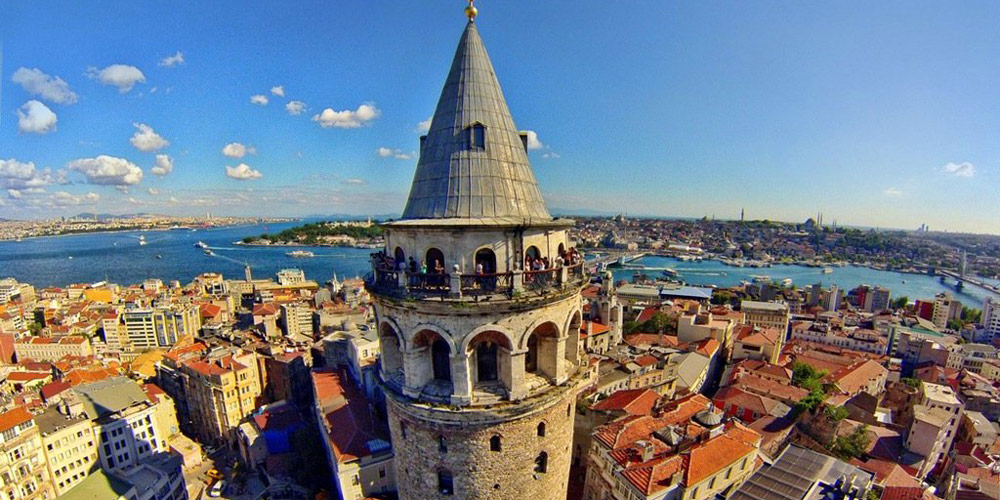Turkey
 City and Province of Istanbul
City and Province of Istanbul
N41 0 30.492 E28 58 47.748
Date of Inscription: 1985
Criteria: (i)(ii)(iii)(iv)
Property : 678 ha
Ref: 356
Historic Areas of Istanbul
With its strategic location on the Bosphorus peninsula between the Balkans and Anatolia, the Black Sea and the Mediterranean, Istanbul has been associated with major political, religious and artistic events for more than 2,000 years. Its masterpieces include the ancient Hippodrome of Constantine, the 6th-century Hagia Sophia and the 16th-century Süleymaniye Mosque, all now under threat from population pressure, industrial pollution and uncontrolled urbanization.
Outstanding Universal Value
Brief synthesis
Strategically located on the Bosphorus peninsula between the Balkans and Anatolia, the Black Sea and the Mediterranean, Istanbul was successively the capital of the Eastern Roman Empire, and the Ottoman Empire and has been associated with major events in political history, religious history and art history for more than 2,000 years. The city is situated on a peninsula which is surrounded by the Golden Horn (Haliç), a natural harbor on the north, the Bosphorus on the east and the Marmara Sea on the south. The Historic Peninsula, on which the former Byzantium and Constantinople developed, was surrounded by ancient walls, built initially by Theodosius in the early fifth century.
The Outstanding Universal Value of Istanbul resides in its unique integration of architectural masterpieces that reflect the meeting of Europe and Asia over many centuries, and in its incomparable skyline formed by the creative genius of Byzantine and Ottoman architects.
The distinctive and characteristic skyline of Istanbul was built up over many centuries and encompasses the Hagia Sophia whose vast dome reflects the architectural and decorative expertise of the 6th century, the 15th century Fatih complex and Topkapi Palace – that was continually extended until the 19th century, the Süleymaniye Mosque complex and Sehzade Mosque complex, works of the chief architect Sinan, reflecting the climax of Ottoman architecture in the 16th century, the 17th century Blue Mosque and the slender minarets of the New Mosque near the port completed in 1664.
The four areas of the property are the Archaeological Park, at the tip of the Historic peninsula; the Suleymaniye quarter with Suleymaniye Mosque complex, bazaars and vernacular settlement around it; the Zeyrek area of settlement around the Zeyrek Mosque (the former church of the Pantocrator), and the area along both sides of the Theodosian land walls including remains of the former Blachernae Palace. These areas display architectural achievements of successive imperial periods also including the 17th century Blue Mosque, the Sokollu Mehmet Pasha Mosque, the 16th century Şehzade Mosque complex, the 15th century Topkapi Palace, the hippodrome of Constantine, the aqueduct of Valens, the Justinian churches of Hagia Sophia, St. Irene, Küçük Ayasofya Mosque (the former church of the Sts Sergius and Bacchus), the Pantocrator Monastery founded under John II Comnene by Empress Irene; the former Church of the Holy Saviour of Chora with its mosaics and paintings dating from the 14th and 15th centuries; and many other exceptional examples of various building types including baths, cisterns, and tombs.
Criterion (i): The Historic Areas of Istanbul include monuments recognised as unique architectural masterpieces of Byzantine and Ottoman periods such as Hagia Sophia, which was designed by Anthemios of Tralles and Isidoros of Miletus in 532-537 and the Suleymaniye Mosque complex designed by architect Sinan in 1550-1557.
Criterion (ii): Throughout history the monuments in Istanbul have exerted considerable influence on the development of architecture, monumental arts and the organization of space, both in Europe and the Near East. Thus, the 6,650 meter terrestrial wall of Theodosius II with its second line of defence, created in 447, was one of the leading references for military architecture; Hagia Sophia became a model for an entire family of churches and later mosques, and the mosaics of the palaces and churches of Constantinople influenced both Eastern and Western art.
Criterion (iii): Istanbul bears unique testimony to the Byzantine and Ottoman civilizations through its large number of high quality examples of a great range of building types, some with associated artworks. They include fortifications, churches and palaces with mosaics and frescos, monumental cisterns, tombs, mosques, religious schools and bath buildings. The vernacular housing around major religious monuments in the Süleymaniye and Zeyrek quarters provide exceptional evidence of the late Ottoman urban pattern.
Criterion (iv): The city is an outstanding set of monuments, architectural and technical ensembles that illustrate very distinguished phases of human history. In particular, the Palace of Topkapi and the Suleymaniye Mosque complex with its caravanserai, madrasa, medical school, library, bath building, hospice and imperial tombs, provide supreme examples of ensembles of palaces and religious complexes of the Ottoman period.
Integrity
The Historic Areas of Istanbul include the key attributes that convey the Outstanding Universal Value of Istanbul as the parts of the city that had escaped major changes and deterioration in the 19th and 20th centuries and were already protected by national legislation at the time of inscription.
Vernacular timber housing in the Süleymaniye and Zeyrek quarters, was recognized as vulnerable at the time of inscription. Despite the threat of pressure for change, many efforts have been executed in order to conserve and strengthen the timber structures within the site since then. Changes in the social structure within the area have also affected the use of those structures. The urban fabric is threatened by lack of maintenance and pressure for change. The Metropolitan Municipality is attempting to rehabilitate the area to revive its degraded parts. The revival of the Süleymaniye and Zeyrek quarters is a long project which demands a long and careful process of cleaning, conservation and restoration. The Suleymaniye Complex has retained its structural and architectural integrity, except some minor changes in the commercial part of the compound. Zeyrek Mosque, originally the Church of Pantocrator, has suffered from several earthquakes.
The integrity of the major monuments and archaeological remains within the four Historic Areas are largely intact but they are vulnerable due to the lack of a management plan. With the management plan, which is under approval process by related authority, it is aimed to address all the issues and solve the problems within the site gradually. The setting of the Historic Areas of Istanbul and the outstanding silhouette of the city are vulnerable to development.
Authenticity
The ability of the monuments and vernacular housing to express truthfully the Outstanding Universal Value of the Historic Areas of Istanbul has been compromised to some extent since inscription in terms of their design and materials. The conservation and restoration works in the setting of the Historic Peninsula are being led and followed by the central and local authorities as well as newly established institutions with the financial funds provided by the legal amendments.NThe setting and distinctive skyline of the Historic Peninsula continues to express the Outstanding Universal Value of the property. However the ongoing ability of the wider maritime setting to do this depends on ensuring that development does not compromise views of the skyline.
Source: Unesco.org

